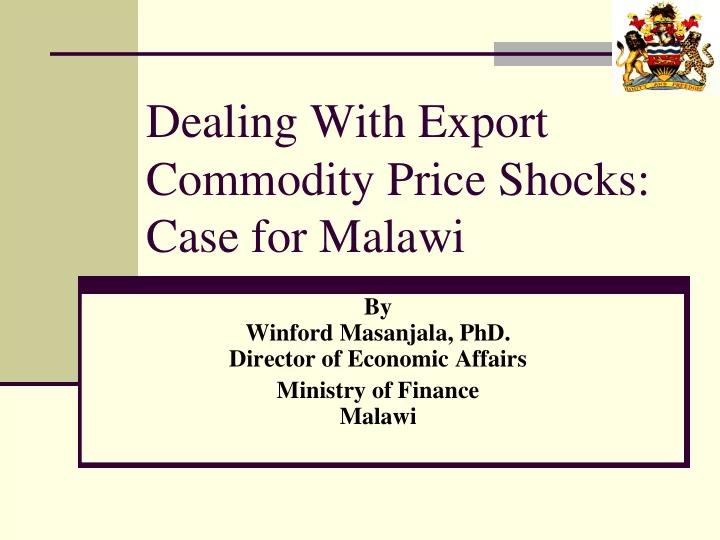

Dealing With Export Commodity Price Shocks: Case for Malawi By Winford Masanjala, PhD. Director of Economic Affairs Ministry of Finance Malawi
Outline of Presentation Malawi’s Economic Structure; 1. Malawi’s Export Commodities; 2. Volatility of Prices of Export Commodities; 3. Impact of Export Price Shocks on Economy; 4. Government and Private Sector Reaction to Export Price 5. Shocks; and Lessons Learned. 6.
Background Small, land-locked country Population:13.1 million growing @ 2.6% pa GDP estimated at US$4.8 billion in 2009, equivalent to per capita income of US$344 (IMF, 2009); The GDP growth rate averaged 7.0 per cent between 2005 and 2010; Net importer of oil, fertiliser and other commodities Trade Deficits now stands US$695 million.
Structure of Production
•Malawi’s economy is Agro based •Employs about 85% of the labour force •Contributes over 80% of merchandise exports; TOBACCO TEA
Malawi Export Commodities Export Commodity Value of exports in Percentage of % Change of 2010 (K, millions) total exports Exports (2009 - (2010) 2010) Tobacco 87,490 69.95 - 21.84 Tea 12,079 9.66 20.07 Sugar 10,371 8.29 7.10 Pulses 4,181 3.34 44.22 Clothing 2,838 2.27 25.55 Cotton 2,478 1.98 - 5.41 Nuts 2,424 1.94 - 42.16 Rubber 1,433 1.15 83.81 Coffee 712 0.57 60.53 Wood-Sawn 576 0.46 - 71.18 Spices 334 0.27 - 102.10 Hides and Skins 97 0.08 - 24.74 Wooden Furniture 58 0.05 - 1,063.79 Source: Annual Economic Report 2011
Yet volumes have been stagnant
Volatility of Prices of Tobacco •1991-95; 25% •1995-97; 33% •1997-04; 20% •2004-09: 50%. •2009- 10: 22% •2010/11: 37%
Impact on the Economy was small 2007 2008 2009* 2010* 2011* Inflation (annual average) 8.0 8.7 8.4 7.4 7.0 Central Govt Revenue excluding 19.0 21.3 22.5 24.4 24.3 grants (percentage of GDP) Expenditure and net lending 30.8 41.4 35.2 35.5 30.5 (percentage of GDP) Overall fiscal balance (percentage of -2.8 -5.0 -0.7 -1.5 0.4 GDP) Net domestic debt (percentage of 11.9 19.9 22.0 15.3 11.8 GDP) Months of import cover 3.5 2.4 1.9 3.1 2.2 *Estimates and projections Source: Annual Economic Report 2011
How does private sector react to shocks? Impact of international tobacco price shocks on household not nationally felt due to food surplus Households and tobacco companies operate according to cob-web theory Year following the shock, output of alternative cash crops rise Tobacco production fell by 21% Labour moved from tobacco into other sectors;
How does Govt reduce impact of shocks? (1/2) In 2008/09, fiscal impact not felt due to increased budget support by Donors. However, Central Bank posted loss and was recapitalised Given narrow tax and commodity base Malawi faces constraints; But policies undertaken include: Maintenance of Petroleum Stabilisation Fund Continued Subsidy on parrafin as pro-poor fuel Continued Fertiliser subsidy to increase food production
How does Govt reduce impact of shocks? (2/2) Diversification away from traditional crops [i.e. tobacco] 1. A. Encouraging farmers to go into cotton [2011] B. Investment in pigeon peas [2012] Diversification away from Agriculture 2. A. Encouraging Mining B. Establishment of Export Finance Fund Value Addition 3. A. Value addition on traditional agricultural [cigarettes] B. Value addition on non-agriculture commodities [e.g. mining]
Lessons Learned There’s covariance in commodity prices. Need forex 1. sources that don’t co-vary with commodity prices Need micro-level cash crop and macro-level export 2. diversification away from agriculture to reduce vulnerability; Better infrastructure and lower transport costs would 3. result in greater returns for farmers Scaling up programmes such as subsidy and social 4. cash transfer; Insurance products are needed for nations and 5. smallholder farmers.
Thank You Zikomo
Recommend
More recommend